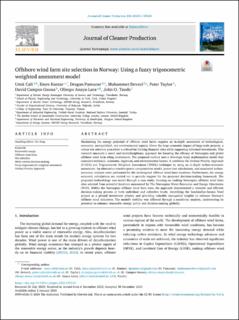| dc.contributor.author | Cali, Umit | |
| dc.contributor.author | Kantar, Emre | |
| dc.contributor.author | Pamučar, Dragan | |
| dc.contributor.author | Deveci, Muhammet | |
| dc.contributor.author | Taylor, Peter | |
| dc.contributor.author | Campos-Gaona, David | |
| dc.contributor.author | Anaya Lara, Olimpo | |
| dc.contributor.author | Tande, John Olav Giæver | |
| dc.date.accessioned | 2024-03-20T12:05:18Z | |
| dc.date.available | 2024-03-20T12:05:18Z | |
| dc.date.created | 2024-01-04T10:48:54Z | |
| dc.date.issued | 2024 | |
| dc.identifier.issn | 0959-6526 | |
| dc.identifier.uri | https://hdl.handle.net/11250/3123380 | |
| dc.description.abstract | Maximising the energy potential of offshore wind farms requires an in-depth assessment of technological, economic, sociopolitical, and environmental aspects. Given the large economic impact of large-scale projects, a robust site selection procedure is critical for limiting financial risks while supporting informed investments. This research uncovers a novel and multidisciplinary approach for boosting the efficacy of Norwegian and global offshore wind farm siting investments. The proposed method uses a two-stage fuzzy mathematical model that considers technical, economic, logistical, and environmental factors. It combines the Ordinal Priority Approach (F-OPA) and Trigonometric Weighted Assessment (TRWA) technique by using an in-depth techno-economic assessment. An alternative reactive power compensation model, power loss calculations, and associated techno-economic analysis were performed for the investigated offshore wind farm locations. Furthermore, the energy economic calculations are carried out to provide support for the proposed decision-making framework. The proposed methodology was tested through a case study, focusing on ranking Norwegian offshore wind farm sites selected from potential locations announced by The Norwegian Water Resources and Energy Directorate (NVE). Within the Norwegian offshore wind farm sites, the approach demonstrated a versatile and efficient decision-making process at both individual and collective levels, identifying the Sandskallen-Sørøya Nord project as a pivotal investment priority and providing valuable managerial insights to enhance Norway’s offshore wind initiatives. The model’s stability was affirmed through a sensitivity analysis, underscoring its potential to enhance renewable energy policy and decision-making globally. | en_US |
| dc.description.abstract | Offshore wind farm site selection in Norway: Using a fuzzy trigonometric weighted assessment model | en_US |
| dc.language.iso | eng | en_US |
| dc.publisher | Elsevier | en_US |
| dc.rights | Navngivelse 4.0 Internasjonal | * |
| dc.rights.uri | http://creativecommons.org/licenses/by/4.0/deed.no | * |
| dc.title | Offshore wind farm site selection in Norway: Using a fuzzy trigonometric weighted assessment model | en_US |
| dc.title.alternative | Offshore wind farm site selection in Norway: Using a fuzzy trigonometric weighted assessment model | en_US |
| dc.type | Peer reviewed | en_US |
| dc.type | Journal article | en_US |
| dc.description.version | publishedVersion | en_US |
| dc.rights.holder | The Authors | en_US |
| dc.source.volume | 436 | en_US |
| dc.source.journal | Journal of Cleaner Production | en_US |
| dc.identifier.doi | 10.1016/j.jclepro.2023.140530 | |
| dc.identifier.cristin | 2220466 | |
| dc.relation.project | Norges forskningsråd: 321954 | en_US |
| dc.source.articlenumber | 140530 | en_US |
| cristin.ispublished | true | |
| cristin.fulltext | original | |
| cristin.qualitycode | 2 | |

